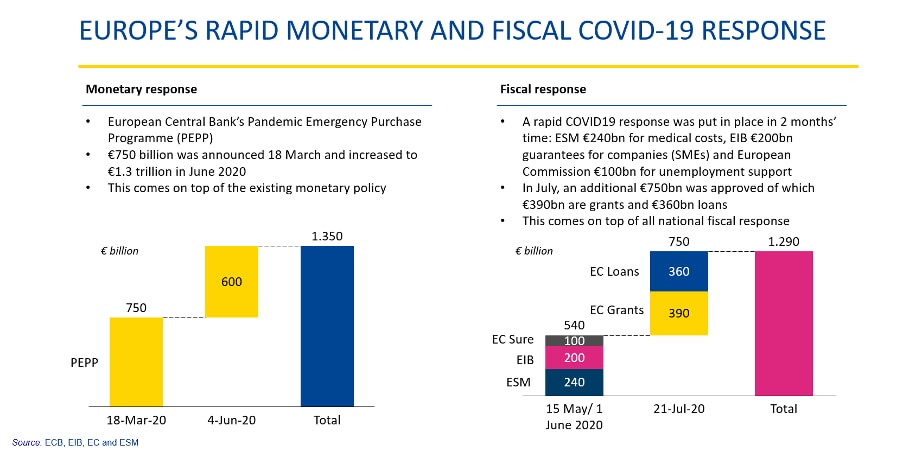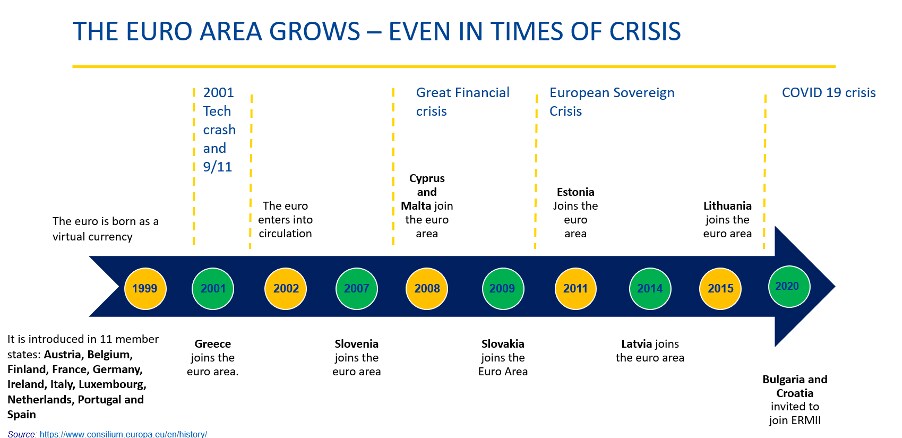What we can learn from Europe's response to the COVID-19 crisis

Europe came together to save lives, jobs and businesses during the COVID-19 pandemic – here's how. Image: REUTERS/Gonzalo Fuentes
Kalin Anev Janse
Chief Financial Officer and Member of the Management Board, European Stability Mechanism (ESM)Iliyana Tsanova
Deputy Managing Director, European Fund for Strategic Investments, European Investment Bank- Europe came together to save its citizens, businesses and member countries during the COVID-19 pandemic, making it a role model for the world.
- The EU’s bold monetary and fiscal response demonstrated solidarity and strengthened Europe’s position globally.
- The European Green Deal will drive recovery in Europe and make European standards the world's standards.
The immediate reaction to COVID-19 in Europe was not exemplary. Critical medical health supplies were held in national warehouses while borders were closed, with a “my nation first” reaction, as European Commission President Ursula von der Leyen described it.
But Europe learned, and learned fast. Within weeks, European countries came together to save lives, jobs and businesses.
The first steps
First, the European Central Bank launched the €750 billion Pandemic Emergency Purchase Programme, a monetary package to counter the risks to liquidity and the outlook for the euro area. It was upgraded to €1.35 trillion just two and a half months later.
A massive pan-European crisis response package followed. The European Commission (EC), European Investment Bank (EIB) and European Stability Mechanism (ESM) agreed to finance up to €540 billion to help people, businesses and countries throughout Europe, including liquidity support to companies, funding for development of treatments and vaccines, and financing for employment as well as direct and indirect healthcare costs related to the pandemic.
Europe did its best to get back on track. Governments intervened with unprecedented support measures targeting households, businesses and self-employed. The EU supported national efforts by providing flexibility in state aid regulations and fiscal rules.
On the road to recovery
The economic shock was far more severe than initially anticipated. The IMF expects euro area GDP to contract by 10.2% in 2020, bouncing back with 6% growth in 2021 depending how the pandemic unfolds. Some sectors (aviation, tourism, culture and art) shut down completely for weeks, while others (energy, oil and gas, automotive) were severely hit. Supply chains were interrupted, which exposed the EU’s vulnerability and dependency on resources outside the trading bloc, especially for medical supplies.
The EU needed bold action to get economies moving again and ensure the bloc would emerge from the crisis stronger, not weaker. German Chancellor Angela Merkel and French President Emmanuel Macron proposed a €500 billion European Fiscal Response, on top of what countries planned to do nationally. This was increased to €750 billion by the European Commission and – after 90 hours of negotiations – agreed to by the European Heads of State and Government on 21 July 2020. It consists of €390 billion in grants and €360 billion in loans.
This is a historic event for the EU for several reasons.
First, the European Commission will issue more common debt on the capital markets (to be repaid until 2058), which could bring the European safe asset – together with EIB and ESM – towards €2 trillion.
Second, it is a step towards a stronger European common fiscal response in time of crisis, strengthening the position of Europe globally.
Finally, it shows real European solidarity. Money would flow from the wealthier countries to the hardest-hit and lower-income ones. This unprecedented stimulus package comes on top of an ambitious seven-year budget of the EU, or Multiannual Financial Framework (MFF).

Towards a green, smart and sustainable future
With the launch of the European Green Deal, the EU made a bold statement to become the global leader in green technologies and economic sustainability. The European Green Deal is now the growth strategy of Europe. The investments supported by the EU recovery package and budget will be fully in line with its objectives to have a climate-neutral economy. The EU Sustainable Finance Strategy and taxonomy will channel private capital to environmentally sustainable investments and unlock the full potential of capital markets to achieve the climate goals. This important policy initiative will trigger a substantial change in the investment mindset of the private sector. Furthermore, Europe is well-positioned in this role, as the euro is already the leading currency globally in green finance.

To stay competitive in the era of a rapid technological transformation, Europe needs to step up its investment in research and development and adoption of digital technologies and relevant skills. The COVID-19 pandemic revealed the importance of digitalization for businesses and the public sector. During the lockdown, firms and countries with integrated digital technologies have performed better than those that have not. The crisis triggered substantial and probably permanent changes in the way we live, work, shop and learn. This plan will ensure Europe reaches the forefront in the digital age.
Meanwhile, in the middle of the crisis, the EU agreed to move to the next stage of accession negotiations with North Macedonia and Albania. Rather than closing itself off, the EU continues building bridges. The cherry on the top is the July 2020 agreement on the entrance of Bulgaria and Croatia to Exchange Rate Mechanism (ERM II), which means that after two years, the two countries might join the euro; similarly, during the Eurocrisis, Latvia, Lithuania and Estonia joined the euro. This shows that crisis does not undermine the attractiveness of the union and the single currency.

Europe as a global role model
Despite the crisis, Europe has firmly stood by the concept of multilateralism – collaborating to seek solutions and showing solidarity with hard-hit nations within and – equally important – outside the European Union. Therefore, Europe has also looked beyond its borders, collecting €7.4 billion to support measures fighting COVID-19 and ensure poor countries have access to potential vaccines and treatments.
Europe has tried – with best intentions – to serve both its own and global citizens through a soft power well described by fellow Young Global Leader Anu Bradford in her latest book, The Brussels Effect. To put it another way, leading European standards often become global standards.
And in the COVID-19 crisis, Europe might be a role model, in the way it has protected its citizens, business and member countries – while at the same time, showing global leadership in the best interest of humanity.
What is the World Economic Forum doing to manage emerging risks from COVID-19?
Don't miss any update on this topic
Create a free account and access your personalized content collection with our latest publications and analyses.
License and Republishing
World Economic Forum articles may be republished in accordance with the Creative Commons Attribution-NonCommercial-NoDerivatives 4.0 International Public License, and in accordance with our Terms of Use.
The views expressed in this article are those of the author alone and not the World Economic Forum.
Stay up to date:
The Great Reset
Related topics:
Forum Stories newsletter
Bringing you weekly curated insights and analysis on the global issues that matter.
More on Geographies in DepthSee all
Naoko Tochibayashi
October 30, 2025







